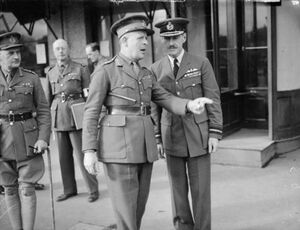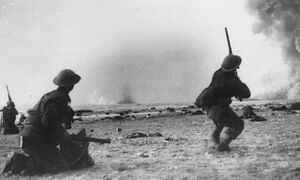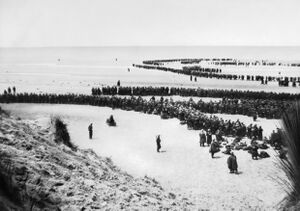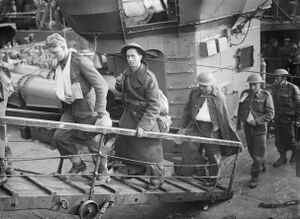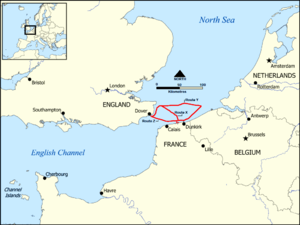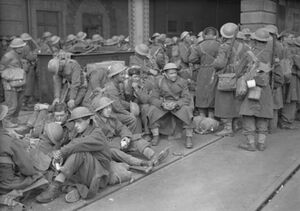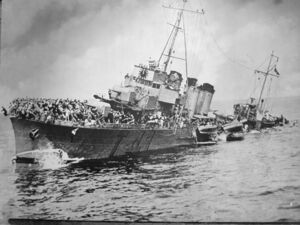إخلاء دنكرك
| العملية دينامو | |||||||
|---|---|---|---|---|---|---|---|
| جزء من معركة فرنسا في الحرب العالمية الثانية | |||||||
 British troops evacuating Dunkirk's beaches | |||||||
| |||||||
| المتحاربون | |||||||
|
| |||||||
| القادة والزعماء | |||||||
|
| |||||||
انسحاب دانكرك الحرب العالمية الثانية أو عملية دينامو هو انسحاب قامت به فلول القوات البريطانية المنهزمة في أوروبا أمام القوات الألمانية خلال بدايات الحرب عام 1940 إذ انحصرت القوات البريطانية في منطقة ميناء دانكرك، في شمال فرنسا، بين 26 مايو و 4 يونيو 1940. The operation commenced after large numbers of Belgian, British, and French troops were cut off and surrounded by German troops during the six-week Battle of France. In a speech to the House of Commons, British Prime Minister Winston Churchill called this "a colossal military disaster", saying "the whole root and core and brain of the British Army" had been stranded at Dunkirk and seemed about to perish or be captured.[7] In his "We shall fight on the beaches" speech on 4 June, he hailed their rescue as a "miracle of deliverance".[8]
After Nazi Germany invaded Poland in September 1939, France and the British Empire declared war on Germany and imposed an economic blockade. The British Expeditionary Force (BEF) was sent to help defend France. After the Phoney War of October 1939 to April 1940, Germany invaded Belgium, the Netherlands, and France on 10 May 1940. Three panzer corps attacked through the Ardennes and drove northwest to the English Channel. By 21 May, German forces had trapped the BEF, the remains of the Belgian forces, and three French field armies along the northern coast of France. BEF commander General Viscount Gort immediately saw evacuation across the Channel as the best course of action, and began planning a withdrawal to Dunkirk, the closest good port.
Late on 23 May, a halt order was issued by Generaloberst Gerd von Rundstedt, commander of Army Group A. Adolf Hitler approved this order the next day, and had the German High Command send confirmation to the front. Attacking the trapped BEF, French, and Belgian armies was left to the Luftwaffe until the order was rescinded on 26 May. This gave Allied forces time to construct defensive works and pull back large numbers of troops to fight the Battle of Dunkirk. From 28 to 31 May, in the siege of Lille, the remaining 40,000 men of the French First Army fought a delaying action against seven German divisions, including three armoured divisions.
On the first day only 7,669 Allied soldiers were evacuated, but by the end of the eighth day, 338,226 had been rescued by a hastily assembled fleet of over 800 vessels. Many troops were able to embark from the harbour's protective mole onto 39 British Royal Navy destroyers, four Royal Canadian Navy destroyers,[4] at least three French Navy destroyers, and a variety of civilian merchant ships. Others had to wade out from the beaches, waiting for hours in shoulder-deep water. Some were ferried to the larger ships by what became known as the Little Ships of Dunkirk, a flotilla of hundreds of merchant marine boats, fishing boats, pleasure craft, yachts, and lifeboats called into service from Britain. The BEF lost 68,000 soldiers during the French campaign and had to abandon nearly all of its tanks, vehicles, and equipment. In his 4 June speech, Churchill also reminded the country that "we must be very careful not to assign to this deliverance the attributes of a victory. Wars are not won by evacuations."[9]
وتطلب سحب هذه القوات التي كانت تربو على مائتين وخمسين ألف، عملية لوجستية معقدة، إذ بالإضافة للقطع البحرية البريطانية اشترك في هذه العملية كل مواطن يملك سفينة أو قارب حيث شكلت هذه الفلول النواة الصلبة التي حاربت على مختلف الجبهات خلال الحرب مما كان له بالغ الأثر على موازين الحرب وحتى يومنا الحاضر لا زال الجدل دائرا حول انسحاب دانكرك وأهميته من قبل بعض المؤرخين والمخططين العسكريين.
. . . . . . . . . . . . . . . . . . . . . . . . . . . . . . . . . . . . . . . . . . . . . . . . . . . . . . . . . . . . . . . . . . . . . . . . . . . . . . . . . . . . . . . . . . . . . . . . . . . . . . . . . . . . . . . . . . . . . . . . . . . . . . . . . . . . . . . . . . . . . . . . . . . . . . . . . . . . . . . . . . . . . . . .
خلفية
افتتاحية
معركة دنكرك
الإخلاء
26–27 مايو
البحرية
مسارات الإخلاء
الأعقاب
تحليل
| التاريخ | الشواطئ | الميناء | الإجمالي |
|---|---|---|---|
| 27 مايو | — | 7,669 | 7,669 |
| 28 مايو | 5,930 | 11,874 | 17,804 |
| 29 مايو | 13,752 | 33,558 | 47,310 |
| 30 مايو | 29,512 | 24,311 | 53,823 |
| 31 مايو | 22,942 | 45,072 | 68,014 |
| 1 يونيو | 17,348 | 47,081 | 64,429 |
| 2 يونيو | 6,695 | 19,561 | 26,256 |
| 3 يونيو | 1,870 | 24,876 | 26,746 |
| 4 يونيو | 622 | 25,553 | 26,175 |
| الإجمالي | 98,671 | 239,555 | 338,226 |
الخسائر
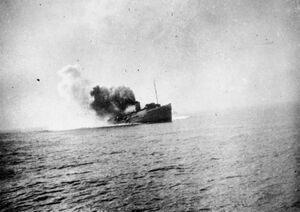
. . . . . . . . . . . . . . . . . . . . . . . . . . . . . . . . . . . . . . . . . . . . . . . . . . . . . . . . . . . . . . . . . . . . . . . . . . . . . . . . . . . . . . . . . . . . . . . . . . . . . . . . . . . . . . . . . . . . . . . . . . . . . . . . . . . . . . . . . . . . . . . . . . . . . . . . . . . . . . . . . . . . . . . .
مقالات متصلة
الهامش
- ^ Biswas 2017.
- ^ Shephard 2003, p. 169.
- ^ أ ب Sweeting 2010.
- ^ أ ب McIntyre 2017.
- ^ Encyclopædia Britannica.
- ^ Ellis 2004, p. 197.
- ^ Churchill 2003, p. 212.
- ^ Safire 2004, p. 146.
- ^ Churchill 1949, p. 115.
- ^ Shirer 1960, Footnote, p. 736.
- ^ Thompson 2011, p. 306.
وصلات خارجية
- Spitfires Join the Fighting – aerial battle over Dunkirk
- Official website of Dunkirk memorial and museum
- BBC Archive – Dunkirk Evacuation
- Dunkirk, Operation Dynamo – Battle of Britain 1940
- Nazis invade France Video analysis on WW2History.com
- BBC Archives – J. B. Priestley's 'Postscript' – radio broadcast from 5 June 1940
- Pages using gadget WikiMiniAtlas
- Articles with hatnote templates targeting a nonexistent page
- 1940 في فرنسا
- 1940 في المملكة المتحدة
- عمليات برمائية في الحرب العالمية الثانية
- معركة فرنسا
- معارك وعمليات في الحرب العالمية الثانية شاركت فيها المملكة المتحدة
- نزاعات 1940
- إجلاء
- تاريخ دنكرك
- أحداث يونيو 1940
- وقفات أخيرة
- أحداث مايو 1940
- معارك وعمليات بحرية في المسرح الأوروپي بالحرب العالمية الثانية
